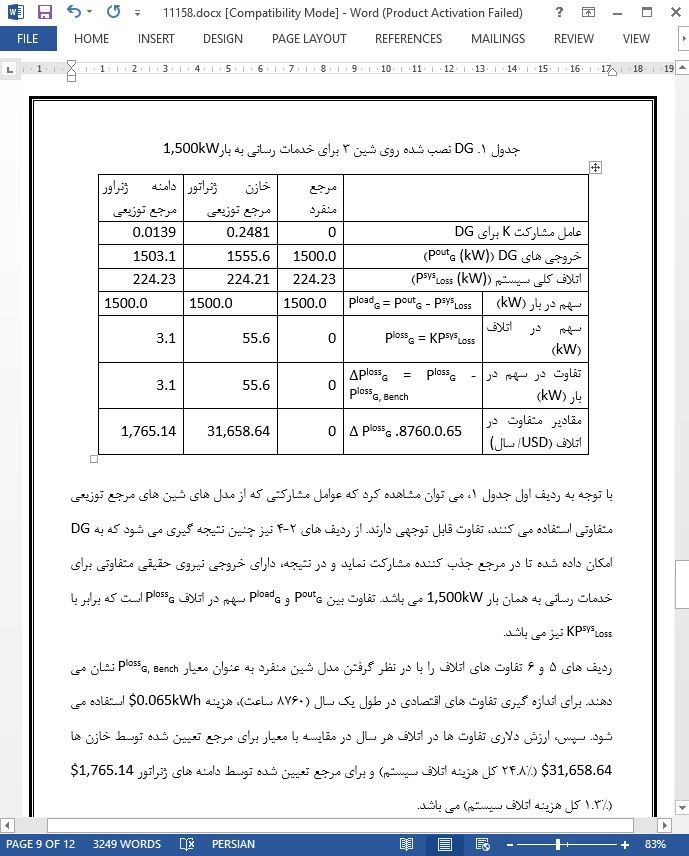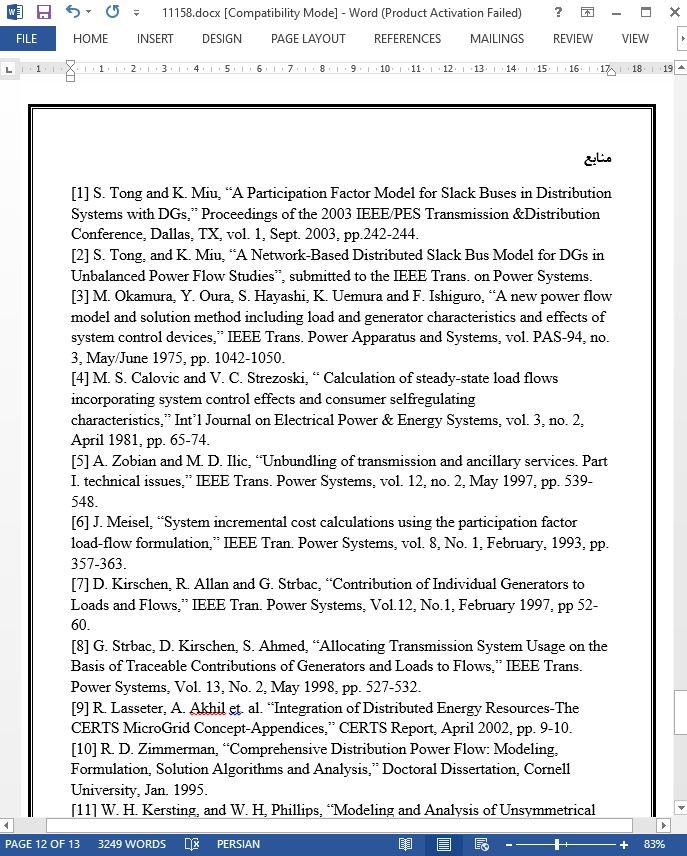
یک مدل توزیعی شین مرجع و تاثیرات آن بر تکنیک های کاربردی سیستم توزیع
چکیده
سیستم توزیعی که در محیط پیرامون مؤثر هستند، به سرعت تغییر می کنند. برای مثال، با افزایش منظم و قابل توجه در تولید پراکنده مورد انتظار، تکنیک های کاربردی و طراحی نیز باید تغییر کنند. این مقاله به ارزیابی مجدد فرضیه شین مرجع می پردازد که معمولا در حلال های جریان نیروی توزیع حالت پایدار مورد استفاده قرار می گیرد. به طور خاص، یک مدل توزیعی شین مرجع که مبتنی بر مفهوم دامنه ژنراتور است، در حلال جریان نیرویی تلفیق شده و مورد بررسی خواهد گرفت. انتظار می رود که بازنمایی بهبودیافته و تقسیم تلفات سیستم توزیع در چندین ژانراتور بر سایر تکنیک های کاربردی نظیر جایابی خازن، احیای خدمات و غیره اثر گذارد. علاوه بر این، تاثیرات اقتصادی تولید پراکنده چشمگیر بوده و نتایج شبیه سازی برای نشان دادن این تاثیرات ارائه خواهند شد.
5. نتیجه گیری
این مقاله به ارائه شبکه ای مبتنی بر مدل شین مرجع توزیعی با عوامل مشارکتی توزیعی برای سیستم های توزیع نامتعادل با DG می پردازد. هدف این مدل توزیع اتلاف سیستم به منایع متعدد در طول محاسبات جریان نیرو است. تاثیرات وارده بر کاربردهای متعدد سیستم توزیع مورد بحث قرار گرفت. نتایج شبیه سازی که بر هزینه های اقتصادی توزیع مرجع با DG تمرکز داشت، نیز ارائه شدند.
Abstract
Distribution system operating environments are changing rapidly. For example, with the steady and significant increase in dispersed generation expected, planning and operating application techniques must also change. The paper re-evaluates the single slack bus assumption typically employed in steady-state distribution power flow solvers. Specifically, a distributed slack bus model, based on the concept of generator domains, is discussed and integrated into a power flow solver. Improved representation and allocation of distribution system losses to multiple generators is expected to impact other application techniques, such as capacitor placement, service restoration, etc. In addition, economic impacts of dispersed generation are significant and simulation results are presented to highlight this impact.
V. CONCLUSIONS
This paper presents a network based distributed slack bus model with iterative participation factors, for unbalanced distribution systems with DGs. The model achieves the purpose of distributing the system loss to multiple sources during power flow calculations. The impacts on several distribution system applications were discussed. Simulation results focusing on the economic costs of distributing the slack with DGs have been presented.
چکیده
1. مقدمه
2. مدل شین مرجع توزیعی
الف. عوامل مشارکت
ب. دامنه های ژنراتور
ج. معادلات جریان نیروی توزیعی
3. کاربردها
4. شبیه سازی ها
5. نتیجه گیری
Abstract
I. INTRODUCTION
II. DISTRIBUTED SLACK BUS MODEL
A. Participation Factors
B. Generator Domains
C. Distribution power flow equations
III. APPLICATIONS
IV. SIMULATIONS
V. CONCLUSIONS
- اصل مقاله انگلیسی با فرمت ورد (word) با قابلیت ویرایش
- ترجمه فارسی مقاله با فرمت ورد (word) با قابلیت ویرایش، بدون آرم سایت ای ترجمه
- ترجمه فارسی مقاله با فرمت pdf، بدون آرم سایت ای ترجمه


